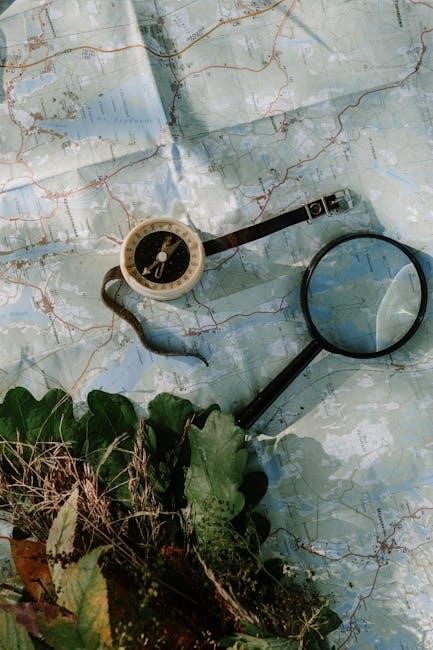Herblore is the study and use of herbs for health‚ wellness‚ and culinary purposes‚ blending traditional knowledge with modern science to harness their natural benefits effectively.
1.1 What is Herblore?
Herblore‚ also known as herbalism‚ is the ancient practice of studying and utilizing plants for their medicinal‚ culinary‚ and therapeutic properties. Rooted in traditional medicine‚ it involves the use of herbs to promote health‚ wellness‚ and sustainability. By understanding the unique characteristics and benefits of plants‚ herblore offers natural remedies for various ailments‚ emphasizing holistic healing and prevention. It bridges the gap between nature and human well-being‚ providing a timeless approach to harnessing the power of plants for a healthier lifestyle.
1.2 Importance of Herblore in Modern Times
Herblore holds significant relevance today‚ offering natural‚ sustainable solutions for health and wellness. With increasing interest in holistic medicine‚ herbs provide alternatives to synthetic drugs‚ promoting prevention and treatment of various ailments. Modern applications extend to skincare‚ culinary arts‚ and eco-friendly practices. Herblore also supports mental well-being‚ bridging ancient wisdom with contemporary needs. Its emphasis on natural remedies aligns with global trends toward organic and sustainable living‚ making it a vital practice for modern lifestyles.

History and Evolution of Herblore
Herblore traces its roots to ancient civilizations‚ where herbs were first used for medicine‚ rituals‚ and culinary purposes. Over centuries‚ practices evolved‚ blending traditional knowledge with scientific advancements‚ shaping modern herbalism.
2.1 Ancient Civilizations and Their Use of Herbs
Ancient civilizations‚ such as Egypt‚ China‚ and Rome‚ laid the foundation for herblore by using herbs for medicine‚ rituals‚ and culinary purposes. Egyptian medical texts like the Ebers Papyrus documented herbal remedies‚ while Chinese herbalism was systematized in the Yellow Emperor’s Classic of Medicine. Similarly‚ Ayurveda in India and Mesoamerican traditions showcased the diverse applications of herbs. These early practices emphasized observation‚ experimentation‚ and spiritual connections‚ forming the cornerstone of herbal knowledge that influenced later traditions.
2.2 Evolution of Herbal Practices Through the Ages
Herbal practices evolved significantly over centuries‚ shaped by cultural exchange and scientific advancements. During the Middle Ages‚ monasteries preserved herbal knowledge‚ while the Renaissance saw a resurgence in empirical studies. The 18th and 19th centuries brought the rise of pharmacology‚ integrating herbalism with modern medicine. Today‚ herbalism blends traditional wisdom with contemporary research‚ emphasizing sustainability and evidence-based practices. This evolution reflects humanity’s enduring quest to harness the healing potential of plants‚ adapting to changing times while honoring ancient traditions.

Understanding the Basics of Herblore
Herblore involves studying plant properties‚ classification‚ and safe usage. It combines botany‚ chemistry‚ and traditional practices to harness herbs’ potential for health‚ wellness‚ and culinary applications effectively.
3.1 Classification of Herbs
Herbs are classified based on their properties‚ uses‚ and characteristics. Common categories include medicinal‚ culinary‚ and magical herbs. Medicinal herbs‚ like calendula‚ are used for healing‚ while culinary herbs‚ such as basil and rosemary‚ enhance flavors. Some herbs are classified by their growth habits‚ like annuals or perennials. Understanding these classifications helps in selecting the right herb for specific needs‚ ensuring safe and effective use in various applications‚ from health remedies to cooking and spiritual practices.
3.2 Understanding Herbal Properties
Herbs possess unique properties that determine their effects and uses. Key properties include antibacterial‚ anti-inflammatory‚ and antioxidant activities. Some herbs‚ like chamomile‚ are soothing‚ while others‚ such as ginger‚ stimulate digestion. Understanding these properties helps in selecting herbs for specific health needs‚ ensuring safe and effective use. This knowledge also guides proper preparation methods to maximize benefits and minimize risks‚ making it essential for both culinary and medicinal applications.
3.3 Safety Precautions and Contraindications
Using herbs safely requires understanding potential risks. Some herbs may cause allergic reactions or interact with medications. Pregnant individuals‚ for instance‚ should avoid certain herbs like pennyroyal. Always consult a healthcare professional before using herbs‚ especially if taking medication or having underlying health conditions. Proper dosing and preparation are crucial to prevent adverse effects. Additionally‚ some herbs may contraindicate with specific health states‚ emphasizing the need for informed use to ensure safety and effectiveness in herbal practices.

Preparing and Using Herbs
Preparing and using herbs involves effective methods for drying‚ storage‚ and preparation to preserve their potency for culinary and medicinal applications‚ ensuring safe and effective use to enhance wellness.
4.1 Methods of Drying Herbs
Drying herbs is essential for preserving their flavor and medicinal properties. Air drying is a popular method‚ using twine to hang herbs upside down in a cool‚ dark place. Oven drying is faster‚ with herbs placed on low heat (150-200°F) for 1-2 hours. Dehydrators offer precise temperature control‚ ideal for large batches. Microwave drying is quick but requires careful monitoring to avoid overheating. Proper drying ensures herbs retain potency and are ready for storage or use in teas‚ tinctures‚ or culinary dishes‚ maintaining their effectiveness and shelf life.
4.2 Storage Techniques for Herbs
Proper storage is crucial to maintain the potency and freshness of herbs. Airtight glass containers are ideal‚ as they protect against moisture and light. Store herbs in a cool‚ dark place‚ such as a pantry or cupboard‚ away from direct sunlight and heat sources. Label containers with the herb name and date for easy identification. For longer storage‚ consider using bay leaves or vacuum-sealed bags. Avoid exposure to air and moisture to prevent spoilage. Regularly check stored herbs for any signs of degradation or mold. Proper storage ensures herbs remain effective for culinary and medicinal use‚ preserving their aroma and healing properties. Always prioritize clean‚ dry environments to maintain quality and safety.
4.3 Common Methods of Herbal Preparation
Herbs can be prepared in various ways to enhance their effectiveness. Infusions and teas are popular for quick absorption‚ while tinctures provide concentrated extracts. Salves and ointments are ideal for topical use‚ combining herbs with carrier oils and beeswax. Decoctions and syrups are used for tougher plant material and easier consumption. Each method ensures the herb’s active properties are preserved and easily absorbed. Proper preparation enhances the herb’s potency and safety‚ making it suitable for specific health needs. Always follow traditional guidelines or consult a herbalist for optimal results and safety.

Herbal Remedies for Common Health Issues
Herbal remedies offer natural solutions for common health concerns‚ from digestive issues to stress relief. Herbs like ginger‚ chamomile‚ and peppermint provide effective‚ holistic approaches to wellness‚ promoting balance and recovery safely.
5.1 Digestive Health and Herbs
Herbs play a vital role in supporting digestive health. Peppermint oil eases irritable bowel syndrome‚ while ginger alleviates nausea and inflammation. Chamomile soothes digestive discomfort‚ and turmeric reduces inflammation. Herbs like fennel and dandelion root aid digestion and relieve bloating. Incorporating these into teas‚ tinctures‚ or capsules can promote a balanced gut. Always consult a healthcare professional before using herbal remedies‚ especially for chronic conditions or sensitive stomachs‚ to ensure safe and effective results.
5.2 Respiratory Health and Herbal Solutions
Herbs offer natural solutions for respiratory health‚ with eucalyptus providing decongestant properties and thyme exhibiting antibacterial benefits. Mullein acts as a natural expectorant‚ easing coughs and congestion. Inhalation of peppermint oil can open airways‚ while ginger reduces inflammation. Herbal teas‚ infusions‚ and salves are effective delivery methods. Always consult a healthcare professional before using herbal remedies‚ especially for chronic conditions like asthma or allergies‚ to ensure safe and appropriate treatment tailored to individual needs.
5.3 Skin Health and Herbal Treatments
Herbs have been widely used to address various skin conditions‚ from acne to eczema. Calendula soothes burns and inflammation‚ while aloe vera gel is renowned for its moisturizing and healing properties. Chamomile reduces redness and calms irritated skin‚ making it ideal for sensitive skin. Lavender oil‚ with its antiseptic qualities‚ helps prevent infections and promotes healing. Herbal teas‚ infusions‚ and salves are popular methods of application. Always consult a healthcare professional to ensure safe and effective use‚ especially for chronic skin conditions like psoriasis or dermatitis.
5.4 Stress Relief and Adaptogenic Herbs
Adaptogenic herbs like Ashwagandha‚ Rhodiola‚ and Holy Basil are renowned for their ability to combat stress and promote balance. These plants help the body adapt to stress by supporting the adrenal system and regulating cortisol levels. Regular use of adaptogens can enhance mental clarity‚ reduce anxiety‚ and improve overall resilience. They can be consumed as teas‚ tinctures‚ or capsules. Incorporating these herbs into your routine may provide natural stress relief and support long-term well-being. Always consult a healthcare professional before starting new herbal remedies‚ especially if you have underlying health conditions.
5.5 Immune Support and Herbal Supplements
Herbal supplements like Echinacea‚ Elderberry‚ and Reishi mushrooms are widely used to boost the immune system. Echinacea is known to enhance immune cell activity‚ while Elderberry is rich in antioxidants that combat pathogens. Reishi mushrooms support immune function and reduce inflammation. These herbs can be taken as teas‚ capsules‚ or tinctures. Regular use may help prevent illness and promote overall health. Consulting a healthcare provider before starting herbal supplements is recommended to ensure safety and effectiveness for individual needs.

Advanced Topics in Herblore
Advanced herblore delves into complex topics like creating custom blends‚ understanding herbal synergy‚ and integrating herbs with modern medicine‚ offering expertise for experienced practitioners.
6.1 Creating Custom Herbal Blends
Creating custom herbal blends involves combining herbs to achieve specific health‚ wellness‚ or culinary goals. By understanding individual herbal properties‚ practitioners can craft synergistic mixes tailored to particular needs. This advanced technique requires careful selection and balancing of herbs to enhance their effects. Custom blends can address stress relief‚ digestion‚ or immune support‚ offering personalized solutions. Modern herbalism encourages experimentation while respecting traditional principles‚ ensuring safe and effective formulations that align with individual preferences and health objectives.
6.2 Understanding Herbal Synergy
Herbal synergy refers to the interaction between different herbs‚ where their combined effects exceed the sum of their individual properties. This concept highlights how certain herbs enhance‚ complement‚ or moderate the actions of others. For example‚ pairing peppermint with ginger amplifies digestive benefits‚ while calendula and aloe vera work together to soothe skin irritations. Understanding synergy allows herbalists to create balanced‚ potent formulations tailored to specific health needs‚ optimizing therapeutic outcomes and minimizing potential side effects. This principle is central to advanced herbal practices and custom blend creation.
6.3 Herbalism and Modern Medicine
Herbalism and modern medicine are increasingly intersecting‚ with many herbs being studied for their potential to complement conventional treatments. Clinical trials have validated the efficacy of certain herbs‚ such as St. John’s Wort for mild depression or turmeric for inflammation. This integration highlights the value of traditional herbal knowledge in addressing modern health challenges. Pharmacognosy‚ the study of medicinal plants‚ bridges herbalism and pharmacology‚ ensuring safe and effective applications. Collaboration between herbalists and medical professionals continues to unlock new possibilities‚ blending ancient wisdom with contemporary science for holistic health solutions.

Herbal Gardening and Cultivation
Herbal gardening involves creating a dedicated space for growing medicinal and culinary herbs‚ requiring proper soil‚ sunlight‚ and water. Regular care ensures healthy plants and potent harvests.
7.1 Setting Up an Herbal Garden
Setting up an herbal garden begins with choosing a sunny location‚ as most herbs require 4-6 hours of direct sunlight daily. Prepare well-draining soil with a pH between 6.0 and 7.0‚ often achieved by mixing potting soil with perlite or sand. Select containers with drainage holes to prevent waterlogged soil. Plant herbs 12-18 inches apart for proper air circulation and water deeply after planting. Mulch around plants to retain moisture and suppress weeds‚ keeping it a few inches away from stems. Regularly monitor soil moisture and adjust watering schedules based on weather conditions.
7.2 Care and Maintenance of Herbal Plants
Proper care involves regular watering‚ ensuring soil is moist but not waterlogged. Most herbs need 1-2 inches of water weekly‚ either from rain or irrigation. Prune plants regularly to promote bushy growth and prevent flowering‚ which diverts energy from leaf production. Provide 4-6 hours of sunlight daily‚ as herbs thrive in bright conditions. Fertilize lightly during the growing season with a balanced‚ water-soluble fertilizer. Mulch around plants to retain moisture and suppress weeds. Monitor for pests like aphids or spider mites and treat promptly with natural remedies like neem oil. Regularly inspect soil health and adjust pH if necessary.
7.3 Harvesting Herbs for Maximum Potency
Harvest herbs at their peak potency‚ typically in the morning after dew evaporates but before noon heat. Use sharp‚ clean tools to avoid damaging plants or introducing contaminants. Pinch or cut leaves and stems just above growth nodes to encourage regrowth. For flowers‚ harvest when fully bloomed‚ and for roots‚ wait until fall or early spring. Dry herbs immediately using air-drying methods or low-temperature ovens to preserve potency. Store in airtight containers in a cool‚ dark place to maintain quality and prevent degradation over time.

Modern Applications of Herblore
Herblore is widely used in cosmetics‚ skincare‚ and modern medicine‚ offering natural solutions for health and wellness. Its culinary applications continue to inspire global cuisine and innovation.
8.1 Herblore in Cosmetics and Skincare
Herblore plays a vital role in modern cosmetics and skincare‚ with herbs like chamomile‚ calendula‚ and lavender being used for their soothing and rejuvenating properties. Many skincare products incorporate herbal extracts to address concerns such as acne‚ aging‚ and sensitivity. Natural ingredients like essential oils and plant-based emollients are increasingly popular in clean beauty trends. Herblore also inspires DIY skincare routines‚ such as herbal face masks and toners‚ promoting sustainable and chemical-free alternatives. This blend of tradition and innovation highlights herblore’s enduring relevance in personal care.
8.2 Herbalism in Contemporary Medicine
Herbalism is increasingly integrated into contemporary medicine‚ with many traditional herbs gaining recognition for their therapeutic properties. Clinical studies validate the efficacy of herbs like echinacea for immunity and turmeric for inflammation. Modern medicine often combines herbal remedies with conventional treatments to enhance outcomes. For example‚ ginger is widely used for nausea‚ and willow bark contains salicin‚ a natural pain reliever. This synergy between ancient practices and modern science underscores herbalism’s evolving role in holistic healthcare‚ offering natural alternatives that align with patient demand for safer‚ plant-based solutions.
8.3 Culinary Uses of Herbs
Culinary herbs add flavor‚ aroma‚ and nutritional value to dishes‚ enhancing both taste and health benefits. Popular herbs like basil‚ rosemary‚ and thyme are staples in global cuisines‚ offering versatility in soups‚ sauces‚ and marinades. Fresh or dried‚ they elevate meals while providing antioxidants and vitamins. Many herbs also aid digestion and immunity‚ making them a natural choice for home cooking. Experimenting with herb combinations can create unique flavors‚ from Italian seasoning to Middle Eastern blends‚ inspiring creativity in the kitchen while promoting wellness through food.

Resources for Further Learning
Explore books‚ online courses‚ and herbal communities for deeper knowledge. Recommended books include The Herbal Medicine-Maker’s Handbook and The Complete Herbal Tutor. Websites like Coursera and herbal forums offer valuable insights and practical guides for advancing your herbalism skills.
- Recommended Books
- Online Courses
- Herbal Communities
9;1 Recommended Books on Herblore
For in-depth learning‚ explore these essential books: The Herbal Medicine-Maker’s Handbook by James Green‚ The Complete Herbal Tutor by Anne McIntyre‚ and Medical Herbalism by David Hoffmann. These texts offer comprehensive insights into herbal remedies‚ plant chemistry‚ and practical applications. They are ideal for both beginners and advanced practitioners seeking to expand their knowledge. Visit your local bookstore or online retailers to discover these valuable resources and enhance your herbal journey.
- The Herbal Medicine-Maker’s Handbook by James Green
- The Complete Herbal Tutor by Anne McIntyre
- Medical Herbalism by David Hoffmann
9.2 Online Courses and Tutorials
and Herbal Gardening Essentials. These courses are ideal for both beginners and experienced practitioners seeking to deepen their understanding of herblore.
- Explore platforms like Udemy and Coursera for herbalism courses.
- Choose courses certified by experienced herbalists for quality learning.
9.3 Communities and Forums for Herbalists
Joining online communities and forums connects you with fellow herbalists‚ offering valuable support and resources. Platforms like Reddit’s Herbalism community and Facebook groups dedicated to herblore provide spaces for sharing knowledge‚ asking questions‚ and learning from experienced practitioners. These forums often feature discussions on herbal remedies‚ gardening tips‚ and product recommendations. Engaging with these communities can enhance your herbal journey and help you stay updated on the latest trends and research in the field of herblore.
- Explore Reddit’s Herbalism community for diverse discussions.
- Join Facebook groups focused on herblore and natural wellness.
- Participate in forums to gain insights and share experiences.

Best Practices for Starting with Herblore
Begin with common herbs like chamomile and calendula. Focus on safety‚ understand herbal properties‚ and start with simple preparations. Seek guidance from reliable sources to ensure safe and effective herb use.
10.1 Setting Up a Home Herbalism Practice
Creating a home herbalism practice begins with a dedicated space for preparation and storage. Invest in essential tools like glass jars‚ grinders‚ and measuring spoons. Store herbs in a cool‚ dark place to preserve potency. Start with versatile herbs such as calendula‚ chamomile‚ and peppermint. Follow safety guidelines and consult reliable sources for recipes and methods. Keep detailed records of your creations and experiences to refine your skills over time. Begin with simple projects like herbal teas or salves before advancing to complex formulations.
10.2 Documenting Your Herbal Journey
Documenting your herbal journey is crucial for tracking progress and refining your practices. Keep a detailed journal to record observations‚ recipes‚ and results. Note the growth and harvest of herbs‚ as well as their effects on health and wellness. Include photos‚ sketches‚ and notes on successful formulations. This record-keeping helps identify patterns‚ optimize blends‚ and share knowledge with others. Regularly reviewing your documentation fosters continuous learning and improves your herbalism skills over time‚ ensuring a personalized and effective practice.
10.3 Continuous Learning and Experimentation
Continuous learning and experimentation are vital for mastering herblore. Explore various herbal combinations‚ techniques‚ and traditions to deepen your understanding. Stay updated on scientific research and traditional practices to refine your skills. Engage with herbal communities‚ attend workshops‚ and experiment with new recipes to gain practical experience. This iterative process fosters creativity‚ adaptability‚ and a holistic approach to herbalism‚ ensuring your practice remains dynamic and effective over time.
